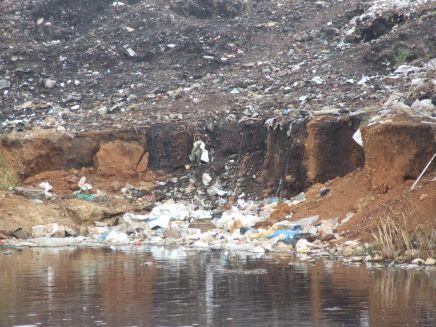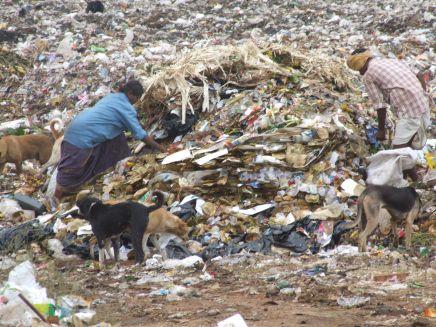Mavallipura Dumping Sites
Background

A significant population of Bangalore today follows western consumption patterns. It is not very difficult to find neighbourhoods and industrial areas with plush lawns, ornamental gardens and parks, glitzy tall buildings and hi tech apartment complexes. Amidst this picture is a small village in north Bangalore that is gasping for breath as the Bangalore Mahanagara Palike (BMP), the city’s municipal corporation, has been unscientifically dumping around 200 truckloads of waste every day since May 2003. The land for this dumpyard has has been taken on a lease from a farmer in the village of Mavallipura, paid handsomely for providing his land in this way.
None of the other villagers were consulted in the process. They realized very soon that not only was the dump bringing them a variety of diseases, but that the unsegregated waste as it decomposed released toxic sludge and slurry into water bodies that were used for drinking and agriculture.
Villagers soon began to suffer form a variety of health problems such as allergic rhinitis, allergic dermatitis, repeated intestinal infections, diarrhea, sleeplessness, cough and upper respiratory tract infections. The affected communities are clear that the cause for these ailments is the dumping and burning of solid waste at this illegal waste dumping site. Water analysis (PDF – 1.6 MB) has confirmed that the leachates and runoff have severely contaminated ground and surface water aquifers. A very high count of coliform bacteria was found in the sample 200m from the dumping site. The samples showed more than the permissible levels of other parameters, including heavy metals in some of the samples.

Water contamination at MavallipuraWhile the Municipal Solid Waste Management Rules are in place and the Supreme Court has required major urban areas to have scientific landfills in place by December 2005, the villagers of Mavallipura continue to suffer on account of this illegal waste dump authorized by the City Municipality without any clearances from Statutory Environmental Regulatory agencies.
ESG has been closely monitoring the issue and has supported the local community in causing the intervention of the Karnataka State Pollution Control Board, which has recently initiated criminal proceedings against the farmer for leasing our the lands for this illegal dump in violation of all norms. ESG is now keen to include BMP (city corporation) as another agency for initiating criminal proceedings.
ESG has been consistently surveying this region to document the amount of waste that is illegally dumped and also to develop possible avenues of compensation for the victims. An attempt is also being made to estimate the extent and kinds of toxic and hazardous wastes find its way into this dump site, with a view to helping the local communities to leverage their cause against such unscientific and illegal practices.

Update, 7 October 2009: Mavallipura Landfill in Yelahanka, Bangalore under seige by villagers – Large numbers of people gathered since morning at Ramky landfill in Mavallipura village were unwilling to let BBMP officials leave unless they shut down this highly polluting facility.
About 20 kms north of Bangalore city, close to Yelahanka town and the Yelahanka Air Force Base, there is a village called Mavallipura. With the tacit approval of Bangalore Mahanagara Palike (BMP), every day since May 2003, about 200 truckloads of municipal solid waste from some of the northern wards of Bangalore are being dumped on 20 acres of land belonging to one Mr. Bylappa from Mavallipura. On average, each truckload of waste weighs about 2.5 to 3 tons. The leachate from the dump is allowed to stagnate in a ditch next to the dump and slowly finds its way into surface and ground water aquifers. Over the years all drinking water sources in the vicinity have been adversely affected, and the threat looms large of contaminating the Arkavathy river, a major drinking water source of Bangalore. It is in this river basin that the Mavallipura dump is located.
Note that a dump is different from a landfill in the way the waste is disposed off. A landfill is a constructed by digging out the earth to form a very large ditch which is provided with an impermeable lining and a leachate collection system to prevent ground water contamination. An outlet for gases formed during decomposition is also provided. A dump in contrast does not have any of these provisions and therefore causes serious air, soil and water pollution.

Water pollution was the far more serious problem because the leachates (containing all kinds of toxic material given the composition of waste generated by a city like Bangalore) seep into the ground and possibly reach the aquifers that are likely to be used as a source of drinking water (among other purposes) by people residing in the area. Theoretically, while the water from the aquifers could be treated for making it potable, in reality, the treatment processes are expensive and therefore it may not be an economically viable option to treat the water and the aquifer may have to be abandoned if the contamination is too high for the safety of those who consume the water.
In Mavallipura, the dumping was carried out next to a forest area and a Eucalyptus plantation. Adjoining the dumping site was agricultural land where crops like ragi (finger millet), avarekaalu (field beans) and flowers are cultivated. Dogs, cattle, cats, crows are some of the animals seen in the vicinity of this area. Vultures are recent additions to the bird population of this area. Additionally, in the vicinity of Mavallipura, there are a few tanks (which are large surface water bodies created to harvest rain in an interlinked pattern) which are part of a chain of lakes/tanks that join the Arkavathy river. Two of these tanks, the Mavallipura Tank and the Koramana Kunte tank, are downstream from the waste dump and hence are polluted by the leaching of pollutants and toxic material from the dump.
As can be expected, this open dumping (and burning) of garbage had resulted in serious environmental pollution including contamination of water bodies here. The villagers of Mavallipura relied on groundwater in this area for their drinking water and cooking needs and faced serious health consequences.
ESG had developed a report on the analysis of the water quality in this area (based on water samples taken here), and the health hazards posed by the contaminants present in this water. The principle objective of water quality testing undertaken by us was to examine if there has been a contamination of groundwater sources due to the all the waste that was being continuously dumped on Bylappa’s land.
This examination was necessary because the villagers use water from underground reservoirs for drinking and the contamination of these sources could pose a health hazard. The water quality test gave an estimate of the level of contamination in the ground water sources of drinking water and this was useful in assessing the risk of health hazard to the villagers of Mavallipura.
Documentation
- Satellite images of the Ramky and Mavallipura landfills, taken from Google Earth on 14 Oct 2009: Mavallipura and Ramky landfills, Distance of landfills from Yelahanka Defence Air Force Base
- Report on water quality in the vicinity of the Mavallipura illegal solid waste dump
- The story of Mavallipura
- Types of waste Poster developed by ESG
- A flipchart on solid waste management developed by ESG
- Urgent Update and Call for Action: Mavallipura Landfill in Yelahanka, Bangalore under seige by villagers – 7 October 2009
Press Release
- Bangalore’s garbage killing people in Mavallipura – Villagers refuse to cremate young victim’s body – 23 July 2010.
- Ramky Landfill at Mavallipura must be phased out – DSS – 16 October 2009.
- Press briefing: Why phase out Ramky Landfill at Mavallipura – 14 October 2009.
Images
Ramky Landfill at Mavallipura



People and protests at Mavallipura




Illegal Dumping Site at Mavallipura: 2003 – 2007
















